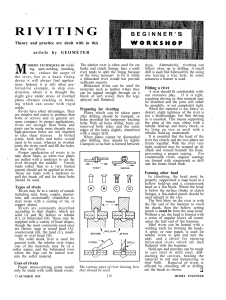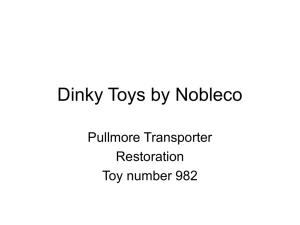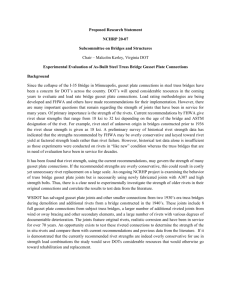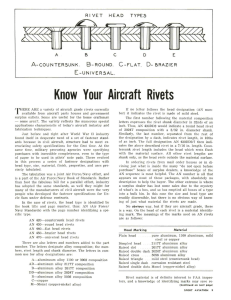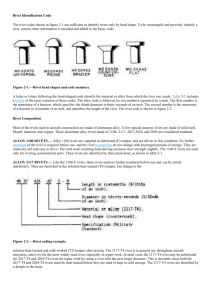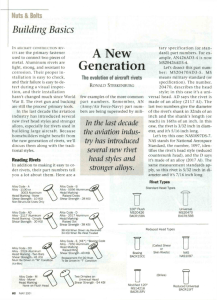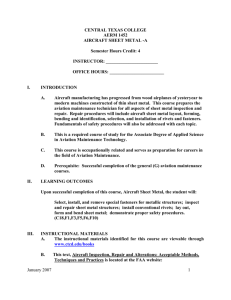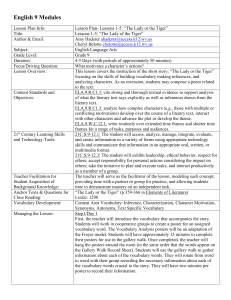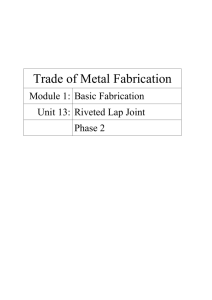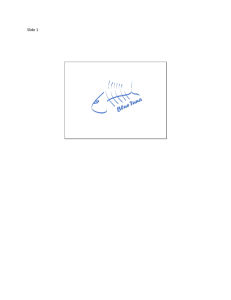Solid Rivet Information
advertisement
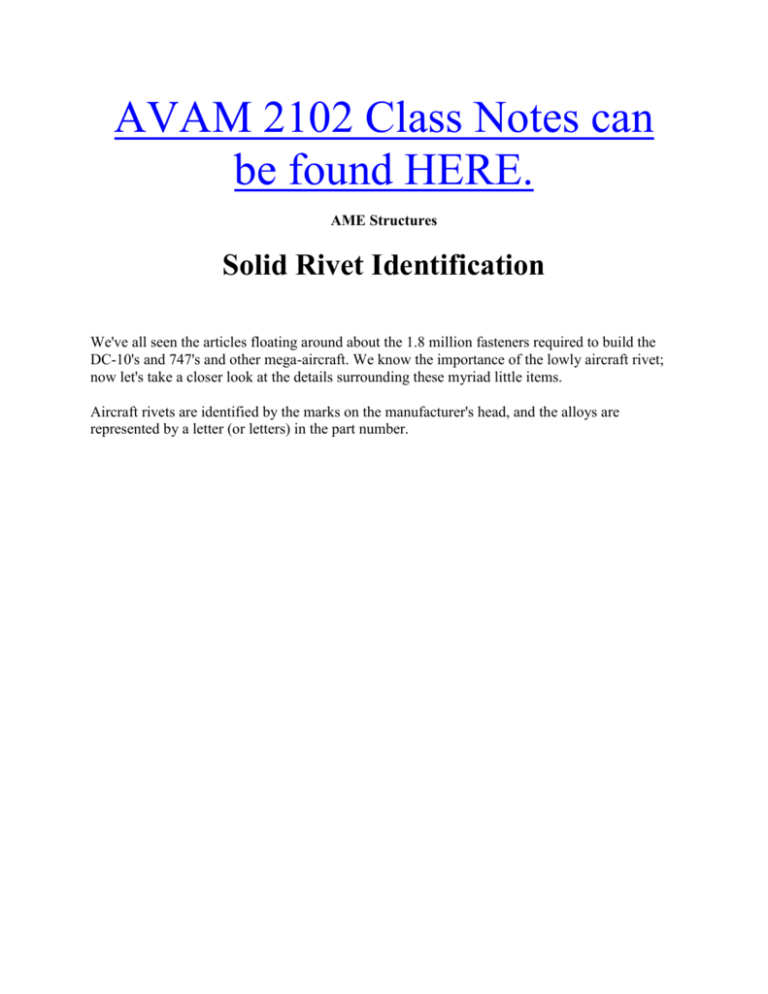
AVAM 2102 Class Notes can be found HERE. AME Structures Solid Rivet Identification We've all seen the articles floating around about the 1.8 million fasteners required to build the DC-10's and 747's and other mega-aircraft. We know the importance of the lowly aircraft rivet; now let's take a closer look at the details surrounding these myriad little items. Aircraft rivets are identified by the marks on the manufacturer's head, and the alloys are represented by a letter (or letters) in the part number. Rivets with no head markings are soft 1100 (pure) aluminum, and not used in structural applications. "B" rivets, alloyed with magnesium is identified with a cross on its head. The most common rivet for AME's is the "AD" rivet with a single dimple in its head, which can be installed without any additional handling. This makes the center of the rivet easier to locate when drilling off the head. Double-dimples on the head (and a heavy silver color) will indicate a monel rivet, usually found in high strength locations or in firewalls where temperature may be a consideration. "D" and "DD" rivets are commonly called icebox rivets because they must be heat treated before use. Following heat treating they must be kept in a freezer for no longer than 20 minutes prior to driving. Aviation rivets are available in 4 common head styles, with the most popular being the AN470 Universal head and the AN426 100° Countersunk head. Note that countersunk rivets, when defining length, include the head. Universal head rivet length defines the shank only, not including the head. Countersunk rivets are primarily installed as a low-drag fastener, but the pricetag for the extra labour required is significant. If the tapered walls for the head of the countersunk rivet has been made by a machine countersinking bit, then material has been removed which will cause a loss in strength. If a dimpling operation was used, then strength is retained, however removing rivets from a dimpled installation can be more time consuming and cause more damage. Of the rivets discussed here, the universal head is the strongest general purpose rivet. One other style of countersunk rivet, the NAS 1097, is discussed further down this page. The MS or AN part number defines the rivet head style, and includes details such as the material (code letters), diameter in 32's of an inch, and length in 16ths of an inch. Some aviation companies purchase optional half-length sizes for their sheet metal technicians. Shank lengths are established as in the diagram: An example part number is: AN426DD3 - 5 This part number calls out a 100° countersunk head rivet made of 2024 aluminum alloy, 3/32" in diameter and 5/16" in length. A rule of thumb for repair of aircraft structure states that AME's should use the same size and head style of rivet as seen in nearby structure. If this is not available, consult the manufacturer's structural repair manual (SRM). Generally, the choice is simplified to universal head or countersunk head AD 2117 rivets. In selecting the diameter of the rivet, use a guideline of at least 3 (three) times the thickness of the thickest sheet. If the repair is being made to an existing aircraft structure, it is common practice to use the same diameter of rivets in adjacent fasteners, preferrably referring to rows inboard or forward on the fuselage. Length is gauged by using the formula of 1.5 times the diameter protruding through the structure. That is to say, if we are riveting two skins of 0.040", then our rivet diameter would be at least 0.120" (or 1/8"), and the length would be estimated at 0.267". We can calculate this length by adding the two skins (.040 x 2) to the diameter-and-ahalf of the rivet (0.187") to achieve a length of 0.267". The nearest size to this length is a 1/4" grip length rivet (a -4). After driving the solid rivet, we should inspect the shop head (also called the "formed" head) for dimensions of .5 x D in height, and 1.5 x D in width. NAS 1097 rivets are a reduced-head countersunk rivet, manufactured in similar materials to the AN426 series. The head size of the 1097 is half the width of the 426, yet retains the 100° head angle. 1097's are not used in tension applications for this reason, but they can be found in smaller skin thickness areas. 1097's are not as widely used as regular AN426 rivets. NAS 523 Rivet Code In certain aviation companies the use of the NAS523 rivet identification code is used on diagrams and drawings. The code embodies a number of details about the rivets to be used in a single 4-cornered symbol, with a "crosshair" at the center. Each quadrant is given a compass designation: NW for northwest, NE for northeast, SW for southwest and SE for southeast. These compass designations are not shown on the code, only the details. In the symbol, the upper left NW corner contains the rivet part number in either AN or MS part numbers, and a rivet material designation. For example, the letters BJ identify a standard MS20470AD rivet, which is made from 2117 alloy. The NE quadrant indicates rivet diameter, and the location of the manufacturers head (Near or Far). The SW quandrant indicates what special methods should be applied to the fasteners, such as dimpling or countersinking. For example, D stands for Dimpling, D2 stands for Dimple both sheets, and D2C means Dimple two top sheets and countersink the third. The lower right corner specifies fastener length in 1/16" increments. Example: a 3/8" rivet is shown as a -6. See the NAS523 Rivet Code sheets for full details.
